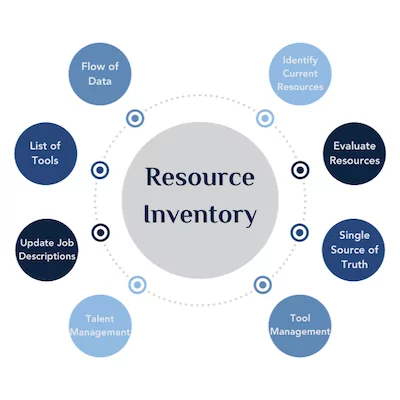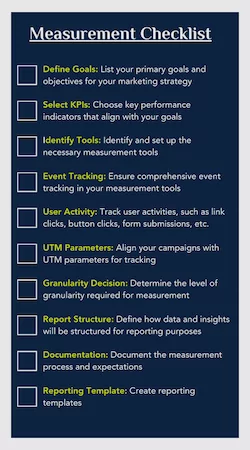Insights
A marketing strategy might live in a static document in your Google Drive or in a slick slide deck, but it can’t be left alone, to collect dust. A lot can happen in one year. A lot can happen in one day in some industries. Stay away from static strategies and follow this 11 step checklist to maintain a dynamic, flexible strategy for your year starting in Q1, or whenever your team needs a strategy kickstart. Ready to dive in?
1. Reflect on the Past
“Live in the moment” might be a great way to spend your life outside of the office, but spending some time with your head firmly in the past is a great way to make sure you’re set up for success in a new year.
Collect the data from campaigns, dashboards, and ad hoc requests throughout the year and put together the story of your last 12 months. It doesn’t need to be exhaustive. It’s (probably) not going to do any good to know bounce rates on Tuesdays vs Wednesdays. But find trends in the numbers most relevant to your goals. Grab your website conversion rate over time from Google Analytics. Does it point to previously unknown seasonality? Pull funnel metrics from your CRM. Did the quality of your leads increase along with volume, or is something else happening?
And don’t forget to celebrate your wins from the previous year. Take the team to happy hour. Hand out awards. Hand out bonuses! The year will go much more smoothly with a happy team that’s fully bought-in.

Take a look back and complete these tasks:
- An SEO audit
- A content audit
- Previous year post-mortem
2. Account for Changes
Now that we’ve learned from the past, it’s time to get back to the present. We look at previous data to inform future decisions.
In a perfect world, you’d find Campaign A resulted in an x% increase in leads last year. So you can recreate Campaign A for the new year for an x% increase in leads again. Only this year is, by definition, not last year. We have to account for changes in the industry, economy, and even internal forces.
Take a look at both internal and external factors. Identify changes that will impact how you do business. Look for increased competition, which means each dollar is going to have to work harder this year. Look for buyer’s tastes and habits to change. Is your persona still your persona?
Internally, a price or feature change could fundamentally change what you’re marketing. If there’s leadership turnover, company priorities are likely to shift and you’ll need to be more flexible than usual. Or maybe a round of venture capital is about to close and you’ll need to figure out what to do with the extra $10M in cash and growth expectations (what a problem to have!).
Account for significant changes and complete these tasks:
- Review ideal buyer personas
- Perform stakeholder interviews
- SWOT analysis
3. Identify Data Gaps
You’ve looked back. You’ve looked around your industry and company. What’s missing?
Chances are while you were doing your research, you weren’t able to find answers to 100% of your questions. It’s frustrating, but it’s an opportunity to get ahead of it for the year to come. Don’t try to solve your data gaps yet, that’ll come later. Just make a note of every piece of information you thought you had, or wish you had, to answer the questions that are most meaningful to your organization’s success.
Hopefully you won’t have a long list, but break it down into both qualitative questions without answers and quantitative metrics that haven’t been captured. Identify data gaps and complete these tasks:
- Make a list of metrics you can’t find
- Make a list of questions you can’t answer
4. Inventory Resources
There’s going to be plenty of time in your year to execute. In step four, we’re still building a framework, and a case for how to attack the next 12 months.
In order to execute you’ll need a team, with both capacity and the necessary tools. What’s in your marketing stack now? Is your CRM flexible enough to handle your unique lead flow and follow up? Do you have analytic suites capable of capturing the metrics and insights missing from step three?
You’ll want to avoid needless spending on tools and identify a single source of truth for marketing KPIs. You can have a robust tech stack, customized through endless webhooks and API endpoints, but there should still be one place to turn for answers. Identify tools with overlapping capabilities and plan for their removal. Be more human about your talent management decisions, but also be honest about where your team needs help. Hire, train, or partner with an agency to fill talent gaps.
Inventory your resources and complete these tasks:
- Create a flowchart of data through your systems
- List your tools, by category, and mark “keep,” “remove,” or “evaluate.”
- Update job descriptions

5. Celebrate Ideas Big + Small
Steps one through four are very practical and focused heavily on constraints. Forget all of those constraints for now.
Imagine you have all the tools at your disposal, a giant team of experts, and a leadership team giving you blank check. What would your year look like?
Get the whiteboard out. Order-in lunch. Have some drinks if it’s not frowned upon in your office. Have some good old fashioned fun brainstorming with the team. Plan a national TV campaign. Imagine your interactive booth at the conference of the year. You’ll find out what your team is passionate about, and get good ideas that might scale to a more realistic budget. Try structuring the brainstorm around funnel stages; brainstorm different lists for awareness, consideration, and conversion.
Then, repeat the process for easy wins. What are things you could fix, or execute, now, that’ll still make an impact. Think things like cleaning up social media profiles, re-engaging PR connections, or automating an email drip to cart abandoners.
Brainstorm and complete these tasks:
- Whiteboard session(s)
6. Set Annual Goals
There’s not a list out there on building a successful strategy that doesn’t contain goal setting.
It’s one of those things we all know we need to do, but still put off or don’t take seriously. Set goals. Set quantifiable goals. Set goals based on the data collected in previous steps, and industry benchmarks where possible.
Likely, your ultimate goal is going to be a revenue number. You might have input into that goal, or it might be handed to you. Either way, make sure your secondary goals lead directly to organizational success. That doesn’t mean every goal needs to be a sales-related conversion rate or qualified lead volume. Softer metrics like employee retention may be just as important to your bottom line.
Set goals and complete these tasks:
- Define organizational and department primary and secondary goals
- Set individual goals with team members
7. Plan for Measurement
Time to solve your data gaps. You’ve outlined your primary goals, including a set of KPIs.
Now you need to make sure the systems you have in place will capture the right data to know if you’re meeting or falling short of your shiny new goals.
The complexity of this step will vary greatly from organization to organization. But one
Ensure your media team, analysts, and agency partners are on the same page with campaign UTM parameters. How granular will you need to be to keep on top of your goals? Or maybe making sure everything rolls up into easily reportable chunks across channels is more important. Whatever the plan, documenting the process and reporting expectations will be a key to its success.
Map a measurement plan and complete these tasks:
- Complete a UTM parameter workbook
- Create GTM tags and triggers
- Build a reporting template or executive dashboard
8. Settle on a Budget
There’s a very good chance this step gets thrust upon you pre-goal setting. Ideally, you’re building your budget in conjunction with goal setting.
Take your quantifiable goals and back into the number needed to achieve them based on the data and insights collected in earlier steps. Make sure you’re prioritizing your dollars the same way your goals are prioritized.
Make sure you’re accounting for the tools and hiring changes outlined previously. And use rules-of-thumb to kickstart the process. Most marketing budgets should fall somewhere between 6-20% of gross revenue. It’s a big range, but tailor it to your situation. Then take that bucket and split it into the marketing levers you’ll be pulling to hit your goals.
This includes things like paid media, content strategy, conferences, tools and administrative expenses. Keep costs lower for the activities that won’t directly impact goals, but don’t lose sight of indirect impact and long-term value.
Settle on a budget and complete these tasks:
-
Budget workbook with line items from brainstorm session
-
Set process for tracking spend
9. Focus on Your Website
Whether informational or transactional, a website is a brand asset that should be front and center of any ongoing strategy.
It’s a unique piece of the marketing ecosystem because improvements can have both short and long-term impacts.
Tackle low effort, high impact tasks from your SEO audit first. Things like missing title tags or incomplete sitemaps can be quick turnarounds with huge results. Then map out a regular process for optimizations from both your SEO and content audits. It takes time to write topic clusters, untangle a messy site architecture, and get the biggest impact from SEO. Map capacity to site priorities and use a monthly cadence to review those priorities and progress.
Always have a test running. Tools like Google Optimize make it too easy to run tests on your pages to leave updates to chance. Like above, use a monthly cadence for testing conversion rate optimizations and hypothesis testing.
Focus on your website and complete these tasks:
-
Create optimization schedule
-
Build a content calendar
-
Implement a testing tool
10. Refresh Campaigns
There are a few good reasons to regularly update advertising creatives and messaging.
First, campaigns get stale. Even the best ads will fade into the background after the 30th, 50th view. Second, in step 2, you most likely identified significant changes in your product, brand, or audience. The same messaging that worked over the last 12 months, might not accurately reflect your product, service, or brand anymore. Engage an agency if in-house resources are limited or stretched too thin by other efforts.
It’s not just the splashy TV or social media creatives that need a facelift. Identify and update outdated content in less sexy campaigns, like email workflows. Take the time to ensure the workflows themselves, their cadence, triggers, and goals, also reflect your current brand positioning and goals.
Use this time to audit and clean up gaps you’ve identified in your lead generation strategy. Don’t gloss over lower visibility items like double checking targeting settings, revising landing page templates, and completing social media profiles.
Refresh marketing campaigns and complete these tasks:
-
Audit campaign targeting and settings
-
Create new creatives & messaging
-
Update email workflows
11. Think Far Into the Future
The unfortunate by-product of building a successful marketing strategy is that your organization will be bigger with higher expectations next year.
When attacking your current year’s strategy, make sure you’re not ignoring the long-term implications.
You can hit a lofty lead generation goal if you spend 100% of your budget on middle of the funnel paid media. But by ignoring top of the funnel activities or maybe foregoing an investment in a single source of truth for data, you might set yourself up for failure in year two or three.
An annual strategy really can’t be created in a vacuum. It’s one section of a very long path with (hopefully) no end. Keep repeating these micro steps while keeping the big picture in mind.
Plan beyond the current year and complete these tasks:
-
Rinse and repeat
These 11 steps will help you develop a dynamic marketing strategy that lives and breathes just as your organization does. By analyzing past performance, defining success, and diving into lead gen, your business will be ready to take on the New Year and beyond. And if this sounds great, but overwhelming, Br8kthru strategists are always looking for an opportunity to tag in, provide guidance and an extra set of hands, and jumpstart a marketing strategy.